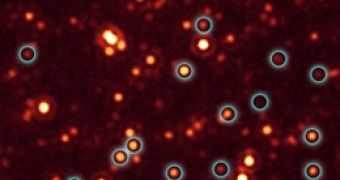Discovered by NASA's Spitzer and Chandra space telescopes, the black holes are located in distant massive galaxies, representing a large fraction of the population predicted by researchers to exist all over the universe. It is generally believed that an extremely large number of black holes was created after the Big Bang, as the universe cooled down.
This evidence shows that massive galaxies in the distant space spent much of the formation time, by creating ultra massive black holes at their cores.
For years the missing black hole population eluded the scientists. These energetic structures are a class of black holes, called quasars. A basic quasar consists of a doughnut-shaped cloud of gas and dust, that surrounds an ultra massive black hole. The black hole's powerful gravity attracts huge quantities of gas, devouring it; in the process, the gas heats up and shoots out X-rays. This is the only known way of discovering a black hole - by studying the black hole's X-ray signature.
Emanuele Daddi of the Commissariat a l'Energie Atomique in France led the research. Daddi and his team initially studied about 1,000 massive galaxies that were thought to lack black holes. The galaxies are about 2.5 to 4.5 billion years old, at a distance of 9 to 11 billion light-years away, have a mass about the same size as our own galaxy, but are irregular in shape.
Using the Spitzer space telescope, the researchers scanned the galaxies using the infrared spectrum, and noticed that about 200 of the galaxies emitted a large amount of infrared light. Chandra's X-ray, revealed that, in fact, the galaxies were hiding plump quasars inside the doughnut shaped clouds surrounding the quasars, which could be the reason for the excessive amounts of infrared light emitted.
These observations also show that galaxy collisions do not play a large role in their evolution, as it was previously believed. It was thought that a collision between two galaxies is necessary to create objects such as quasars. It has been shown that this is not the case, and massive galaxies can form quasars on their own, most of them building up a star and quasar population, until the star formation process is stopped.
The new observations were made as part of the Great Observatories Origins Deep Survey, the most sensitive survey to date of the distant universe at multiple wavelengths.

 14 DAY TRIAL //
14 DAY TRIAL //